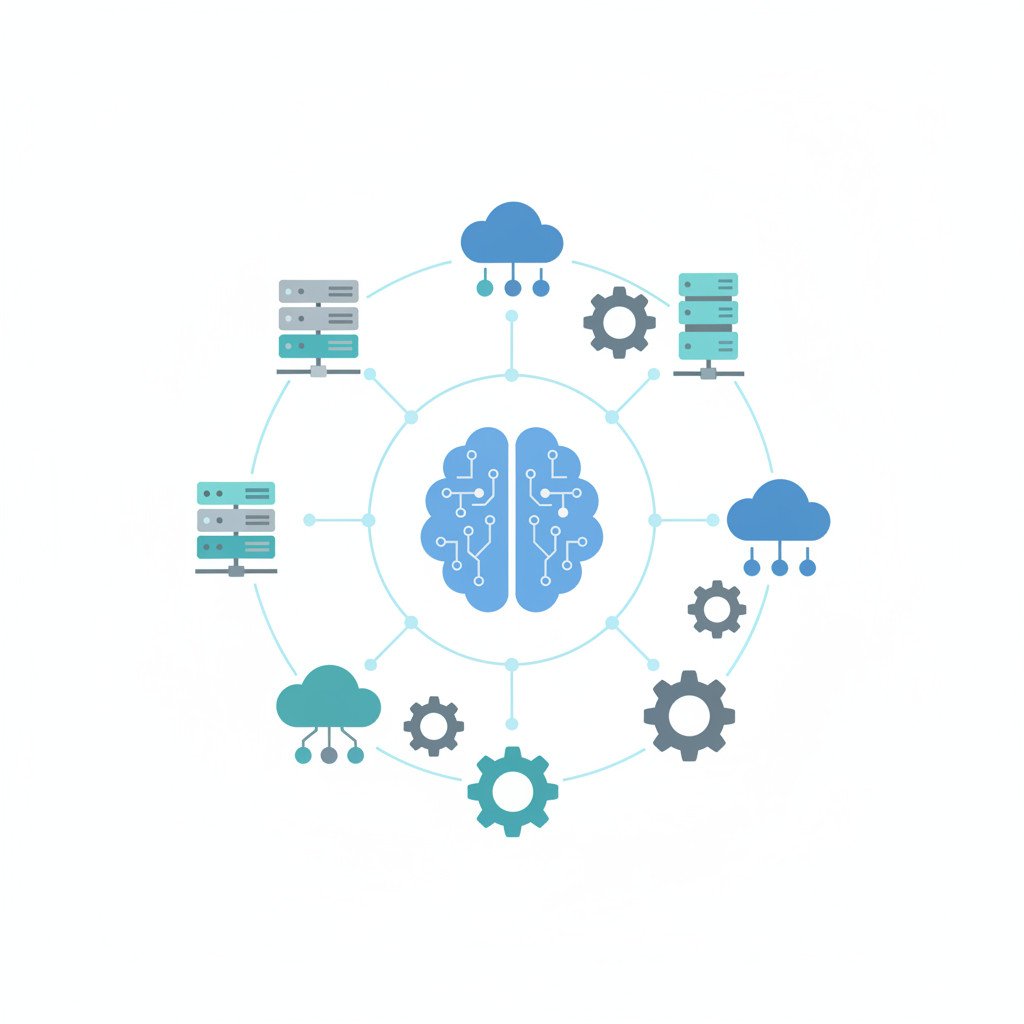AI adoption in IT operations: From reactive firefighting to predictive resilience
AI adoption in IT operations is reshaping how teams detect, diagnose, and resolve incidents. As systems scale, manual processes fail. Therefore, organizations that adopt AI gain speed and predictability. This introduction explains why AI matters, what it realistically delivers, and where teams must invest to succeed.
Why this shift matters
- Faster incident diagnosis because AI analyzes logs and signals at scale
- Reduced mean time to resolution through AI-enabled suggestions and automation
- More proactive operations as patterns reveal likely failures ahead of time
What executives and practitioners should know
AI brings measurable gains, but it is not a cure-all. For example, the best results follow when teams improve processes and data quality. Moreover, self-service portals and ticket automation amplify AI impact. As a result, companies see lower costs and higher uptime when they combine smart tooling with clear workflows.
Read on to explore the data, practical steps, and case examples that show how to move from reactive ops to predictive operations with confidence.

Benefits of AI adoption in IT operations
AI adoption in IT operations delivers measurable improvements across speed, accuracy, and cost. As systems grow, manual troubleshooting becomes slow and error prone. Therefore, teams that apply AI see faster diagnosis, fewer repeat incidents, and clearer prioritization.
Key benefits
- Faster mean time to resolution through AI-assisted troubleshooting and auto-suggestions
- Proactive failure prediction by analyzing patterns across signals and logs
- Improved ticket triage and prioritization using AI scoring and routing
- Cost savings from hours recovered and fewer escalations
Efficiency and cost impact
The numbers show clear gains. For example, a SolarWinds analysis found pre-AI resolution averaged 27.42 hours. After adopting AI tools, resolution time dropped to 22.55 hours. As a result, teams save about 4.87 hours per problem. For a medium-sized team handling 5,000 problems per year, that is roughly 24,350 hours saved and about $680,000 in annual help desk savings at $28 per hour.
Detecting anomalies and predicting failures
AI excels at spotting subtle anomalies in telemetry. Consequently, it identifies trends before incidents escalate. Top 10 AI adopters lowered resolution times from roughly 51 hours to 23 hours. However, prediction only works with quality data and tuned models.
Automating routine tasks and shifting focus
AI automates repetitive tasks like knowledge matching and auto-responders. Therefore, engineers spend less time on rote work. Moreover, teams can focus on system improvements and preventive engineering.
Practical considerations and next steps
AI is powerful but not a silver bullet. Success depends on process change and data readiness. See further guidance at What is AI adoption in IT operations worth?. Also review why AI-ready data matters and manage expectations about capabilities here.
Traditional IT Operations vs AI-enabled IT Operations
| Category | Traditional IT Operations | AI-enabled IT Operations |
|---|---|---|
| Task automation | Manual scripts and human-run tasks. Limited automation and high toil. | Broad automation for repeatable tasks. Runbooks trigger automatically, reducing toil. |
| Anomaly detection | Reactive alerts based on simple thresholds. High false positives. | Pattern and anomaly detection using ML models. Fewer false positives and earlier detection. |
| Response speed | Longer mean time to resolution. Manual diagnosis slows fixes. | Faster resolution by 17 to 30 percent on average. AI suggests root causes and fixes. |
| Cost efficiency | Higher labor costs from repeated manual work. | Hours saved translate to large savings. Example: about 24,350 hours saved annually for a medium team. |
| Scalability | Scaling requires proportional headcount increases. | Systems scale with automation and intelligent routing. Teams add capacity without linear headcount growth. |
| Ticket triage | Manual ticket sorting and inconsistent priorities. | AI scores, routes, and prioritizes tickets automatically. This improves SLAs and reduces escalations. |
| Proactivity and prediction | Ops remain largely reactive to incidents. | Predictive models forecast failures before they occur. Consequently, teams can schedule fixes proactively. |
Challenges and implementation strategies for AI adoption in IT operations
Common challenges in AI adoption in IT operations
Integration complexity often stalls projects. Different tools, legacy systems, and proprietary formats block data flow. Consequently, teams waste time on connectors instead of outcomes. Moreover, patchwork integrations increase maintenance costs and risk.
Data quality and signal noise cause poor model performance. For example, inconsistent logs and missing labels reduce detection accuracy. Therefore, AI produces false positives or misses key incidents. As a result, teams distrust automated recommendations.
Skill gaps and cultural resistance slow adoption. Engineers may lack ML expertise, and operations teams often resist process change. However, leadership can bridge this gap with training and clear incentives.
Actionable strategies and best practices
- Start small with targeted pilots
- Choose a high-impact use case, such as ticket triage. This reduces risk and shows quick wins.
- Invest in data hygiene and observability
- Standardize logs, add metadata tags, and centralize telemetry. Consequently, models learn from cleaner inputs.
- Use modular integrations and APIs
- Prefer lightweight connectors and event-driven architectures. This lowers integration complexity and eases upgrades.
- Build cross-functional squads
- Combine SREs, data engineers, and product owners. As a result, teams align on priorities and measure outcomes.
- Standardize runbooks and feedback loops
- Capture successful AI suggestions as runbooks. Then, feed outcomes back into training data to improve accuracy.
- Train and upskill staff continuously
- Offer workshops, certifications, and hands-on labs. Therefore, teams gain confidence with AI tooling.
Practical governance and expectations
Set clear success metrics, such as mean time to resolution and false positive rate. Also, phase rollouts and monitor impact. Finally, treat AI as a process change, not merely a tool.
Conclusion: Embracing AI adoption in IT operations for sustainable advantage
AI adoption in IT operations is not an optional experiment. It is a strategic lever for faster incident response, lower costs, and more resilient systems. The data is compelling: organizations that deploy AI see meaningful reductions in mean time to resolution and large gains in operational efficiency. Consequently, teams can reallocate effort from firefighting to strategic engineering.
To succeed, combine AI tools with clean data, standardized processes, and cross-functional teams. Start with targeted pilots, measure clear outcomes, and scale steadily. Remember that AI amplifies good processes; it cannot replace them.
EMP0 (Employee Number Zero, LLC) is a practical partner for this transition. EMP0 provides full-stack AI worker solutions and automation tooling that run securely under client infrastructure. Their approach helps multiply revenue and operational capacity while keeping data control and compliance intact. Explore EMP0 services and resources at their website and blog for hands-on guidance.
The future of IT operations is predictive and automated. Therefore, organizations that plan and invest in AI adoption now will gain long-term reliability, efficiency, and competitive advantage.
Frequently Asked Questions (FAQs)
What are the main benefits of AI adoption in IT operations?
AI improves detection, speeds response, and reduces manual toil. Many teams cut mean time to resolution by around 15 to 20 percent, recover engineering hours, and improve ticket triage and knowledge matching.
How hard is it to integrate AI into existing IT systems?
Integration can be complex with legacy tools and siloed data. Start with small pilots, use APIs and modular connectors, and standardize telemetry to simplify rollouts.
What data and process changes are required for success?
Clean, consistent data is essential. Invest in centralized logging, metadata tagging, and documented runbooks. Create feedback loops so AI suggestions become part of training data.
Will AI adoption in IT operations replace human engineers?
No. AI automates routine work and frees engineers for higher value tasks like system design and preventive engineering. Reskill staff and define new career paths.
How should organizations measure ROI and risk?
Track mean time to resolution, false positive rate, automation coverage, and hours saved. Also monitor security, compliance, and data residency. Phase deployments and measure before scaling.
What are the first steps to pilot AI in IT operations?
Pick a high impact, well scoped use case such as ticket triage or anomaly detection. Define KPIs, assemble a cross functional pilot team, run a time boxed pilot, and measure clear outcomes before expanding.
How should organizations address data privacy and compliance?
Classify sensitive data, apply data minimization, encrypt in transit and at rest, and enforce access controls. Validate vendor security, maintain audit logs, and involve legal and compliance teams early.

